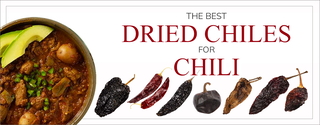The Best Dried Chiles for Chili
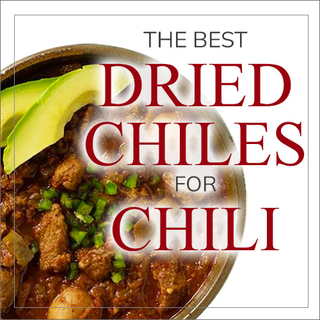
No single chile or group of chile peppers is “best” to use when making a pot of homemade chili. The chiles that you use are dependent on a few things—your personal preferences, what kind of chili you plan to make, and if you’re sticking to a tried-and-true recipe or experimenting with creating your own blend.
The debate about how to make a “proper” chili is passionate, as fiery as the stew at the center of the question. Chili is adored from one side of this country to another, and each region has its preferred recipe.
Americans make chili with beans or no beans. Tomatoes or no tomatoes. Over pasta. With crackers. Or with a side of cornbread. At its best, homemade chili is a masterpiece of regional comfort cooking, flavored with the cook's favorite herbs and spices for chili. Despite local differences and personal preferences, there’s one thing that all the best chili cooks agree on: Chile peppers are a critical ingredient.
For more than a decade, we have been working with dried chiles. Our customers have asked us time and time again to help us determine their best chile for chili. Our years of experience working with dried chiles have been enhanced by feedback from competition-level chili chefs, restaurateurs, and home cooks.
We can help you figure out which chiles will match your flavor and heat preferences and even explain the kinds of flavors that different peppers can express and the questions you should ask when choosing chiles. We suggest pepper combinations of different chilis and when to add chiles to your chili for the best-tasting dish. We also discuss the differences between making a chile paste and a chile powder, even the distinction between chili and chile powder, and the pros and cons of these ingredients.
Table of Contents
Which Chiles To Use For Chili?
When To Add Your Chiles To Chili
Why Use Chile Peppers Instead of Chili Powder
What’s The Difference Between Using Chile Paste and Chile Powder?
Which Chiles To Use For Chili?
To decide which chiles you should use in your pot of chili, you need to consider a few things. You need to consider the flavors of chiles and what they can bring to the pot.
Do you want it to have fruity, smoky, or earthy flavors?
And, of course, you need to ask yourself if you want to use hot or mild dried chiles. Do you like chili with a deeply infused mild chile pepper heat, or do you want it to sparkle with bursts of heat?
There are plenty of ways you can use these versatile ingredients. Some peppers, like the Ancho chile, will complement almost any pot of chili it’s stirred into. Some chiles express multiple flavors, so the same pepper can be considered fruity and earthy. Other peppers are more complementary to particular kinds of chili. Here are the four primary flavors and the Mexican dried chiles you can use in chilis. We’ve also included their heat ratings to get the complete chile pepper snapshot.
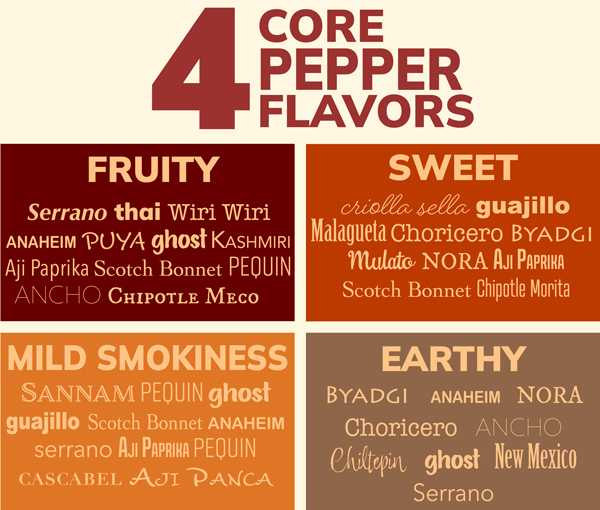
Which Peppers Have A Fruity Flavor?
When a pepper has a fruity flavor, that doesn’t necessarily mean it’s light and unnoticeable. The fruit flavors are often deep and hearty and add even more richness to robust chilis.
| Ancho | Fruity, earthy, bitter, raisin-y, tobacco-y, plummy chocolate. 1,000-1,500 SHU | Good for all kinds of chilis |
| Chipotle Meco | Spicy, fruity, smoky, grassy. 2,500-10,000 SHU | Great with beef or turkey chili |
| Costeno Rojo | Fruity, grassy, nutty, complex, soapy. 5,000-15,000 SHU | Use in chicken or vegetarian chili |
| Habanero | Pungent, papaya, coconut, berry. 150,000-325,000 SHU | Great with fish or chicken chili |
| Pequin | Fruity, mildly smoky, nutty, citrusy. 30,000-60,000 SHU | Great in chicken or seafood chili |
| Puya | Fruity, cherry-like, licorice. 5,000-10,000 SHU | Use in beef or black bean chili |
| Smoked Red Serrano | Fruity, mildly smoky, earthy, acidic. 8,000-18,000 SHU | Add to stews with game, like venison, or standard chilis like turkey or beef |
Which Peppers Have A Sweet Flavor?
Sweet chile peppers are a terrific way to add complexity to a personalized pepper blend by providing some balance amid other elements like heat and smoke.
| Aji Paprika | Sweet, mildly smoky, raisin-y, and tobacco-y. 100-500 SHU | Great in turkey or vegetarian chili |
| Chipotle Morita | Sweet, smoky, bitter, chocolate. 2,500-10,000 SHU | This hearty chile would be delicious in a rich pot of beef or vegetarian chili |
| Guajillo | Sweet, mildly smoky, astringent, piney, tart berries. 2,500-5,000 SHU | Pair this chile with turkey chili or with wild game |
| Mulato | Sweet, smoky, cherry-like, chocolate, coffee, licorice. 1,000-1,500 SHU | This can go in any chili but shines when paired with beef or turkey |
Which Peppers Have A Smoky Flavor?
Smoky chile peppers add tremendous flavor to chilis. These peppers usually have a bold flavor even without the smoke, so use these to get a little assertive with your seasoning.
| Aji Paprika | Sweet, mildly smoky, raisin-y, and tobacco-y. 100-500 SHU | Great in turkey or vegetarian chili |
| Cascabel | Mildly smoky, acidic, nutty, woody, tobacco-y. 1,000-2,500 SHU | Use in beef chili or a vegetarian chili with a sweet element, like butternut squash |
| Chipotle Meco | Spicy, fruity, smoky, grassy. 2,500-10,000 SHU | Great with beef or turkey chili |
| Chipotle Morita | Sweet, smoky, bitter, chocolate. 2,500-10,000 SHU | This hearty chile would be delicious in a rich pot of beef or turkey chili |
| Guajillo | Sweet, mildly smoky, astringent, piney, tart berries. 2,500-5,000 SHU | Pair this chile with turkey or chicken chili or with wild game |
| Pasilla de Oaxaca | Smoky, sharp, tobacco-y. 15,000-20,000 SHU | Great with beef and also in a vegetarian black bean chili |
| Pequin | Fruity, mildly smoky, nutty, citrusy. 30,000-60,000 SHU | Great in chicken or seafood chili |
| Smoked Red Serrano | Fruity, mildly smoky, earthy, acidic. 8,000-18,000 SHU | Add to stews with game, like venison, or more traditional turkey or beef |
Which Peppers Have An Earthy Flavor?
Earthy chiles tend to taste dark and dense, with an element of solidity and woodiness. Use earthy chiles to anchor the flavors in your chilis.
| Ancho | Fruity, earthy, bitter, raisiny, tobacco-y, plummy, chocolate. 1,000-1,500 SHU | Good for all kinds of chilis |
| New Mexico | Sweet, earthy, acidic, cherry-like, weedy. 800-1,400 SHU | Use these peppers in chicken, turkey, or seafood chili |
| Pasilla Negro | Pungent, tangy, woody, rich, raisiny, chocolate. 1,000-1,500 SHU | This is a great base for all kinds of chilis |
| Smoked Red Serrano | Fruity, mildly smoky, earthy, acidic. 8,000-18,000 SHU | Add to stews with game, like venison, or more traditional turkey or beef |
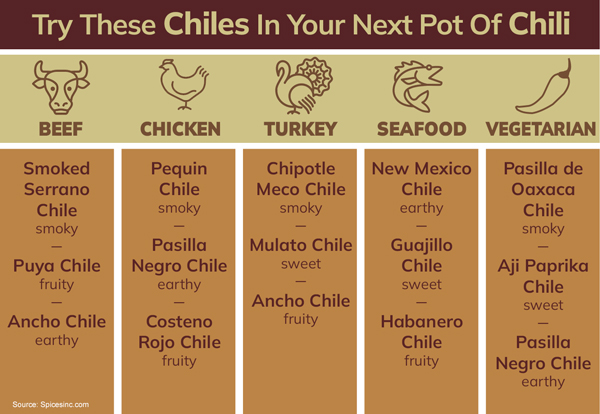
Which Peppers Are Used More For Heat Than Flavor?
Some peppers have a clean and unobtrusive flavor and deliver primarily on heat. Peppers like this can be used in just about any chili you’d like to supplement the heat. These are some of our favorites.
| Chiltepin | Smoky, earthy, sharp. 100,000-250,000 SHU | The heat dissipates quickly, so add this at the end of cooking for the most impact |
| De Arbol | Acidic, grassy, nutty. 15,000-30,000 SHU | This chile’s tough skin makes it a great candidate for a long simmer, which will infuse its heat through the entire pot |
| Japones | Clean, sharp. 15,000-30,000 SHU | Grind and use at the end or simmer as part of the base to infuse heat |
When To Add Your Chiles To Chili
Adding chiles to your chili depends on how you want the flavors of the chiles to disperse throughout your dish. If you add chiles as a flavoring base at the beginning of cooking and let them simmer, the chiles will mellow but permeate the entire dish. If you add chiles toward the end of cooking, then they will be more sharp and pungent in the dish. Their flavors will not be incorporated into the dish’s overall profile but will serve as an accent.
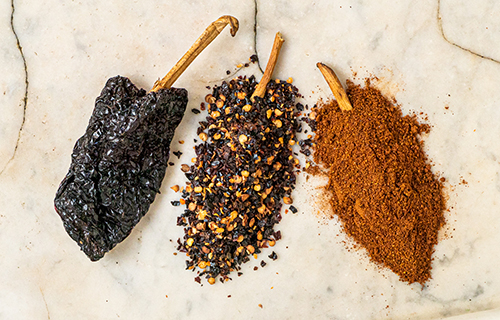
Why Use Chile Peppers Instead of Chili Powder
When you use chile peppers instead of chili powder, you experience the nuances of flavors within individual peppers. An Ancho chile, for example, has a classic and unmistakable “chile pepper” flavor. It’s a little bitter; it’s a bit fruity. It is also bursting with more subtle flavors just below the surface; Anchos are raisiny and plummy, with notes of chocolate and tobacco. Whole peppers allow these next-level flavors to present themselves, making for a more complex dish.
Chili powder is a convenient path to making a good pot of chili. It’s a blend of common peppers, herbs, and spices commonly found in chili. There isn’t a way to highlight the flavors of peppers or personalize a ready-made blend, so the nuances that make a pepper so special are more easily lost in a chili powder blend. These powders are a fantastic convenience, but if you want to make a dish with rich flavors that showcase both peppers and your flair, choose to work with whole dried peppers.
What’s The Difference Between Using Chile Paste and Chile Powder?
A basic chile paste is made from dried chile peppers that are rehydrated and then mashed into a soft paste. It can be concentrated by cooking until it thickens, or you can reduce it by adding a bit of tomato paste to your mashed chiles.
Pastes are a terrific way to form a rich, robust seasoning base for chilis, soups, and stews. They’re entirely broken down, so the nuanced flavors of chiles are accessible and ready to be absorbed into the overall profile of the dish. Since they’re smooth, they can be thoroughly blended into the dish, and if the paste is thickened, it can add some body to your chili.
Powders are made from dried chiles that are best when toasted and milled. They can be as coarse or as fine a grind as you’d prefer, particularly if you’re making the powder yourself. Chile powders store well, are easy to measure, and are more long-lasting than pastes; you can keep a powder for up to a year, while pastes need to be used within a week.
The flavor of a chile powder is not as potent as the flavor you’d get from a paste, and it will get less intense over time, particularly if the powder is not stored correctly. Also, powders can introduce a gritty texture to your dish depending on how much powder you use and the grind’s coarseness.
How To Make A Chile Paste or Puree
The first step when making a chile paste or puree is to toast the chiles. This helps to intensify the flavors in the chiles by stimulating the essential oils locked in the cells. These oils are the keys to the array of flavors that can be found in chile peppers.
If you plan to deseed the peppers, cut them open before toasting, and swipe out the seeds and pithy veins along the pepper’s interior. Toast the chiles in a medium-hot pan for 30 seconds, depending on the chile size. The skins may blister a little but not blacken or burn. Chile should smell fragrant, not acrid. Flip them in the pan to ensure even toasting, and remove them before they start to burn.
Once chiles are toasted, cover them with boiling water and let them soak for 20 minutes or so—again, this depends on the size and type of chile. After chiles have softened, remove them from the soaking water but make sure you taste the liquid! If you think the flavor of the water is pleasant, you can add it to your chili to give even more oomph to the chile pepper flavor.
The softened chiles can then be ground into a paste in a food processor or immersion-style hand blender.
How To Make A Chile Powder
To make a chile powder, start toasting the peppers as you would when making a puree.
Once chiles are toasted, let them get cool enough to handle. Put them in an electric spice grinder or mortar and pestle and grind to desired consistency. Use right away or store in an airtight container for future use.
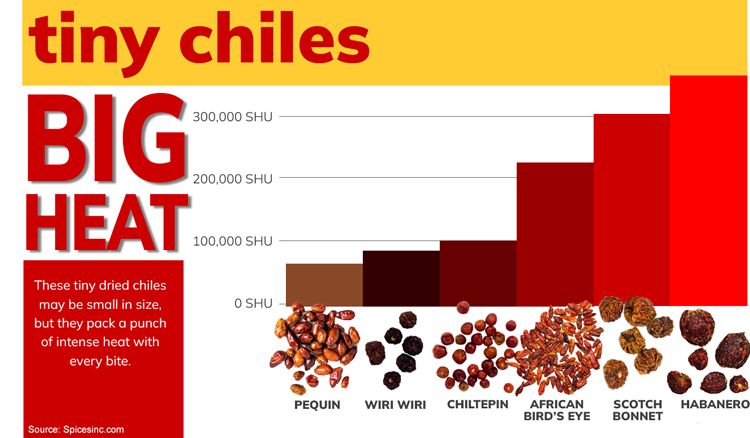
What Other Chiles Can I Use For Chili?
One wonderful thing about chili is that it’s open to your imagination. If you want to try the full-bodied flavor of Aji Amarillo, you should try it! Or you can experiment with the mellow sweetness of Spanish Choricero chiles or the fruity, vegetal flavors of the Caribbean Scotch Bonnet. We wouldn’t dream of telling you to use a Scotch Bonnet in a pot of Texas Red, but aside from this kind of gold-standard chili recipe that is not to be tinkered with, chili is all about experimentation.
Starting is easy. All you have to do is try mixing and matching the flavors you like best, and then comes the fun part: Taste-test your chili to see how close you are to your mark. We recommend you keep notes, so you can easily reference which pepper was too hot for you or which flavor you’d like more—or less!—of in your finished chili.
After some trial and error, you should have a signature blend that you can brag about at the next cookoff or impress friends and family.

